Color glass of traditional Czech chandeliers
Published: Jan 21, 2018
Metal oxides are mainly used during the production of colour transparent glasses used in traditional crystal lighting fixtures. The final colour effect is also influenced by the composition of the raw material (whether it’s sodium, potassium or lead, etc.), as well as the melting process – the so-called oxidation with oxygen access or reduction without oxygen access.
How do we get the resulting glass colour by adding metal oxide?
For illustration we present the colour effects of several of them.
(Fe) – Iron (Green lighting fixtures)
Probably the most common are iron oxides that gives the molten glass a green colour, which in most cases is undesirable. However, glassmakers can use the iron well for the benefit of the object– during reduction melting, the iron gives the molten glass a dark green colour, with restricted access to oxygen, it colours the glass to a green-brown to yellowish, and in the oxidation melting it gives the glass a yellow colour. These iron properties are mainly used in the production of beverage glass, but also in glasses for protection against the effects of UV radiation.
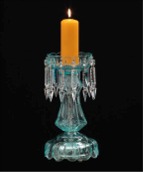 |
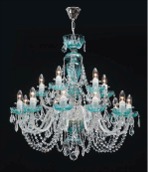 |
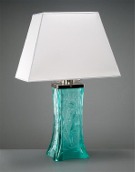 |
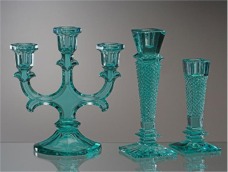 |
(Mn) – Manganese (Amethyst purple glass lamps)
Adding manganese in clean state helps to remove the undesirable greenish effect of "ubiquitous iron" glass to increase glass enamel clarity.
Oxidised manganese, depending on whether it’s divalent or trivalent, gives glass a yellow, brown or amethyst violet colour.
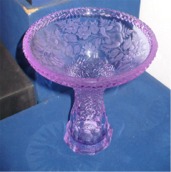 |
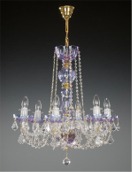 |
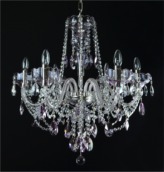 |
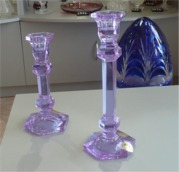 |
(Ni) – Nickel (Dark purple glass lamps)
Also nickel oxide has the ability to colour the glass violet.
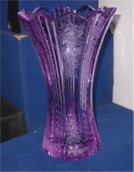 |
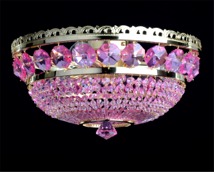 |
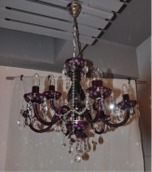 |
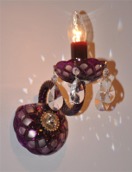 |
(Se) – Selenium (Pink/ Orange glass lamps)
With plenty of oxygen, it colours the potassium potash enamel into pink (Rosaline). It colours sodium glasses in orange and lead glass in yellow.
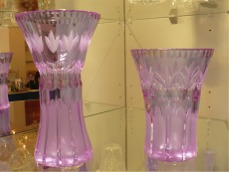 |
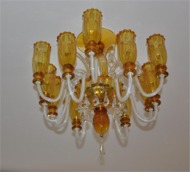 |
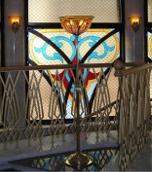 |
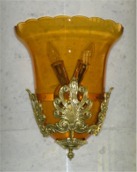 |
(U) – Uranium (Bright yellow-green lamps)
The colour effects of uranium oxide in enamel were discovered in the 19th century by glass master Riedel from Polubná.
A bright yellow-green uranium glass with love named after the wife of the glassmaker Riedel "Anina žlut (Yellow)" and "Anina zeleň (Green)". Glass products of this material certainly won’t be overlooked in an interior.
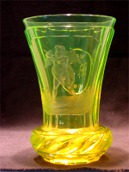 |
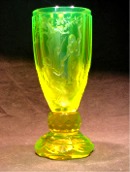 |
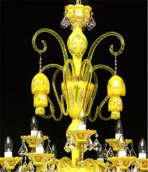 |
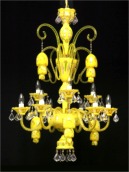 |
(Cr) – Chromium (Green lamps in the colour of grass)
Adding chromium oxide we can acquire a grass-green coloured glass.
(S) – Sulfur, C - Carbon (Amber yellow glass lamps)
Medieval glassmakers already knew that they would get a yellow (amber) colour after adding a small quantity of Sulphur or Carbon.
(Co) – Cobalt (Cobalt blue chandeliers)
A commonly used ingredient for achieving a variety of shades of blue.
(Au) – Gold (Ruby's red lamps and chandeliers)
Since ancient times ruby red glass has been one of the most expensive because it requires genuine gold for its production. The glassmaker alchemist Jan Kunckel, who was accused of witchcraft at the end of the 17th century, is responsible for the discovery of the "golden ruby" – he allegedly coloured the glass with human blood. He managed to save his life, but only with a great deal of difficulty. Even with the use of a small amount of gold chloride, it pays off to scrape a pan with small grains of precious gold.
(Cu) – Copper (Light fixtures in the colour of Czech garnet)
The Czech invention of how to replace the expensive gold ruby is to create ruby with copper.
If this type of ruby glass is applied to pure enamel, the resulting laminated glass is gorgeously red. The resulting red effect can be from brick-red to very dark shades that for example, can be used as a lamp cover in a darkroom.
Copper ruby is formed by the action of copper oxide and reducing agents.
And many more ... see Wikipedia
https://en.wikipedia.org/wiki/Glass_colouring_and_colour_marking
Metal oxides are also used in the production of colour design crystal trimmings. Such chandelier trimmings produce special colour effects - from different angles they can reflect light in another colour (light with different wavelengths).
See PHOTO SHOWROOM
 United States of America
United States of America

